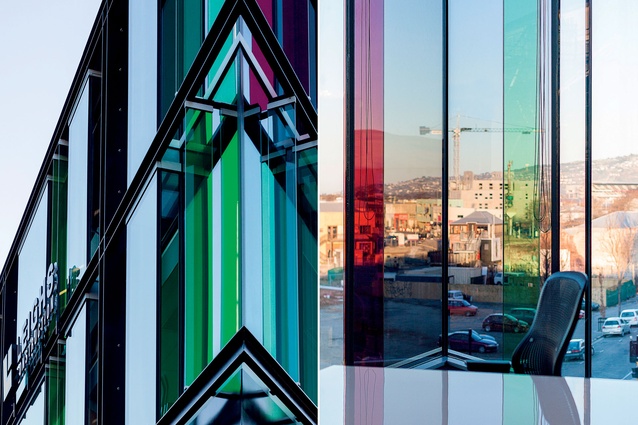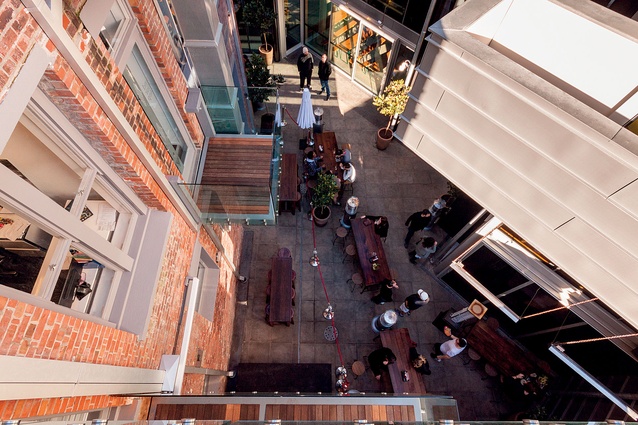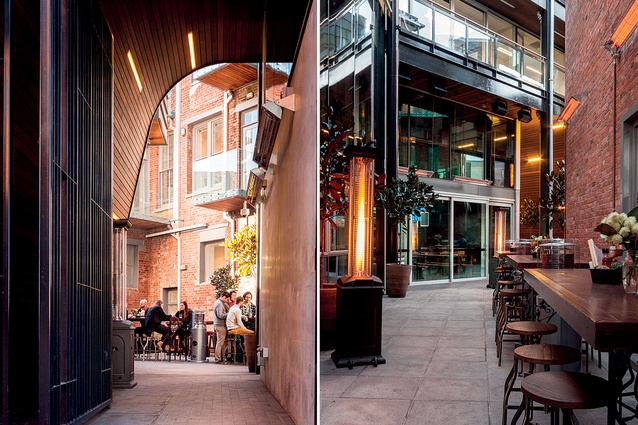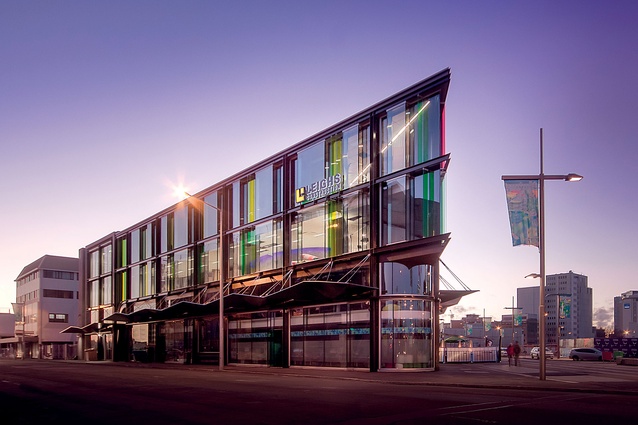Stranges and Glendenning Hill Building
Sheppard & Rout Architects' new multi-purpose building project in Christchurch was one of the first to go through the consent process after the Canterbury earthquakes. Now completed, the building has become an oasis within the heart of a still-devastated city.
Christchurch remains a ghost of a city. I’m certain it’s one of the largest panoramic landscape perspectives you’re likely to find in a central city right now; with whole blocks vacant of buildings, you can see for miles in multiple directions. The Canterbury earthquakes are still present in the ether, as well as in the rubble, of this city and will remain so through into the next generation, no doubt.
It is exciting, finally, to see a few new buildings popping up in the city. Shigeru Ban’s Transitional Cardboard Cathedral sticks out among the ghosts and, appropriately, it has an ethereal and spiritual quality about it. Patterson Associates’ new glasshouse at the Christchurch Botanic Gardens is a white and translucent form that immediately transports you into a heavenly space – ethereal, again. Meanwhile, Sheppard & Rout Architects’ new 2,078m² Stranges and Glendenning Hill Building is altogether different.
On the corner of Lichfield and High Streets, the existing three-storeyed Bonnington’s House building, built in 1882, has been joined by two new buildings, which is known collectively as the Stranges and Glendenning Hill Building, with a series of laneways and, sited in between, a wee shed in the form of a café. The architects were fully aware that an iconic building, the Stranges Building formerly on the site, was demolished and that an appropriate replacement was needed.
From the street corner, the new Stranges Building is no wallflower, with its vibrant, coloured panes of kelly-green and ruby-red glass, forming a rhythm of vertical fins, reminiscent of the stained glass often seen in churches and villas of the time – a nod to Christchurch’s history, perhaps. The proportions are also a contemporary nod to the adjacent Victorian building, broken down in scale to soften the mass of the building, while an expressive folded-steel canopy forms an elegant tutu around its middle, protecting visitors and passers-by from sun and rain.
This scheme was designed relatively quickly after the devastating earthquake of February 2011, thanks mainly to an energetic and forward-thinking client, with the architects completing the concepts in May that year. I’m told that, if this early planning stage had been left any later, the project would have found it difficult to pass through the consent process, such is the bureacracy facing many architects and developers working in the city right now. This design is built to 188 per cent of the current seismic code.
Two impressive two-storeys-high, timber-lined arches provide laneway entry from High and Lichfield Streets, through into a high central courtyard which forces the eye to look up in the way a church might and, yet, this place is grounded in more earthly pleasures: drinking, eating, partying and working. Five offerings give patrons choice of sustenance with Vespa bar in the adjacent old building, Nucleus Bar & Grill across the laneway in the new Stranges Building and Orleans (sister to the Britomart restaurant in Auckland), with its deliberately tobacco-stained windows, and Strange & Co in the Glendenning Hill Building, while the Lower 9th Diner, a rather-fitting tribute to the most devasted area of New Orleans post-Hurricane Katrina, is located within the laneway shed. Yes, they’re mainly themed venues but they’ve been done with consideration, creating a comfortable character and vibrancy that appeals to a younger crowd.
The main office tenant, occupying the upstairs space within Stranges, is Leighs Construction which also happened to be the contractor on the building and liked it so much it decided to move in.
In my view, Stranges’ streetscape could really come to life with the right kinds of tenancy in the ground-floor retail space. The windows need to be opened up, not covered over, as is the case now, perhaps with a fashionable high-street clothing retailer helping to marry the inside with the outside of the building.
The laneway possesses that lovely, lively energy you expect when eating and drinking under the moonlight in parts of Europe. Apparently, the first few nights the laneway was open, there were hundreds of people queuing to get in, such is the need for a more vibrant life in Christchurch. However, drinking laws being what they are (bureaucracy strikes again), the bars in the laneway have had to be cordoned off from one another into sections, breaking up what should be a freely flowing social space, protected from all sides from the wind. There is a variety of materials here, too; everything is broken down to a human scale and the cantilevered balconies overhead add an exciting perspective from below, whilst allowing tenants to become part of the action below, should they wish. I understand that plans are under way to improve lighting and rain cover in the lane for next winter, this will be a welcome addition. There is a column cutting down through the arch at the back that bothers me from several perspectives but, in the scheme of things, it’s a minor gripe.
Certainly, this is an unusual and difficult site; the corner of the building is at a very sharp angle because High Street slices diagonally right through the intersection of Lichfield and Manchester Streets. Sheppard & Rout have made this a prominent architectural feature, however, offering a graphic perspective from the street where the steel and glass interect at a tight angle. Inside, the mezzanine, with its sharply recessed corner, creates a snug alcove with an interesting (and colourful) perspective over this unusual landscape of a city.
One of the most successful architectural devices is an egg-shaped, 500mm-thick, raw concrete core, set back from the edge into the double-height space of both the interior and exterior laneways. The structure of curved in-situ concrete is reassuring in its strength, in a city where people are still nervous of further seismic activity. More egg-shaped holes have been cut into the centre of the mezzanine floor, which has been lined with metal, continuing the raw industrial theme expressed throughout the detailing and fit-out, and within the structure itself. These buildings quite comfortably bridge the old and new.
My feeling is this is an exciting new project for Christchurch and it’s certainly a testament to the client and team who designed and built it within trying times. While having drinks with a number of local people ‘in the know’, I was told that some developers have been effectively forced to sell their plots to the Government for, reportedly, around a third less than their values. It’s no surprise, then, that a good number of developers have left town or lost faith in the process, and that many architects with whom I’ve spoken around the country are concerned about the quality of the city that’s going to be built. But, in spite of everything, there does seem to be hope for Christchurch in these recently completed buildings and the wonderful transitional and art projects dotting many of the vacant plots around the city. Whilst waiting for the bathroom in Orleans, I overheard one visitor state to his friend: “It feels like life is finally returning to the city”.















